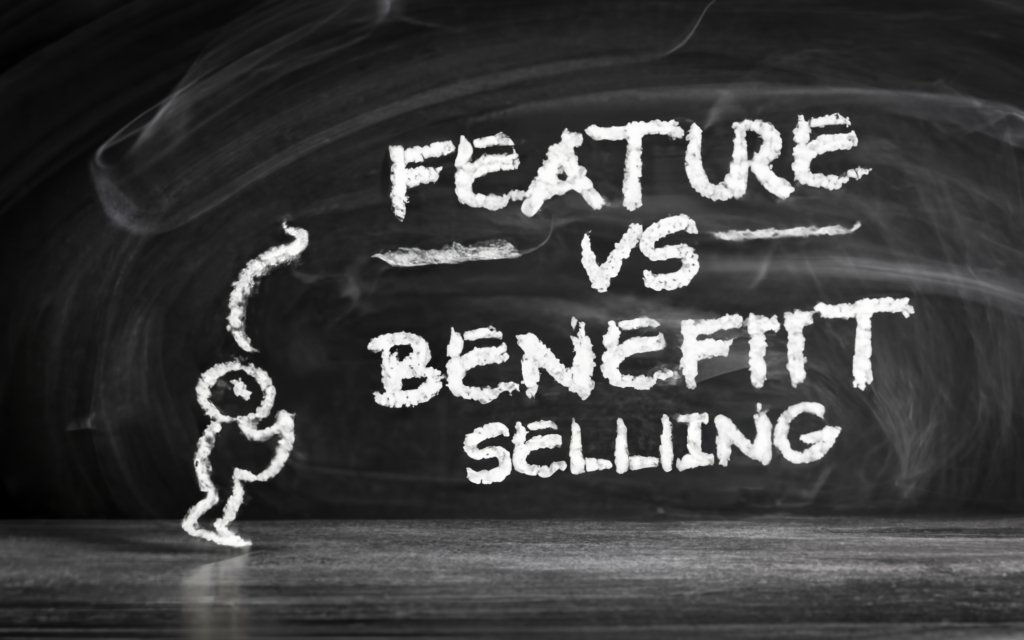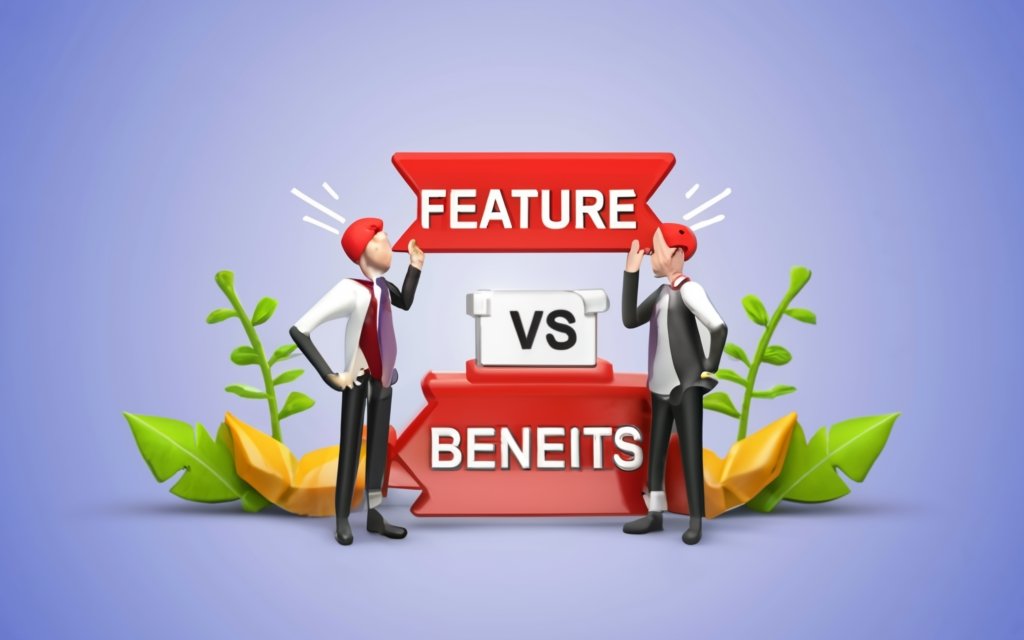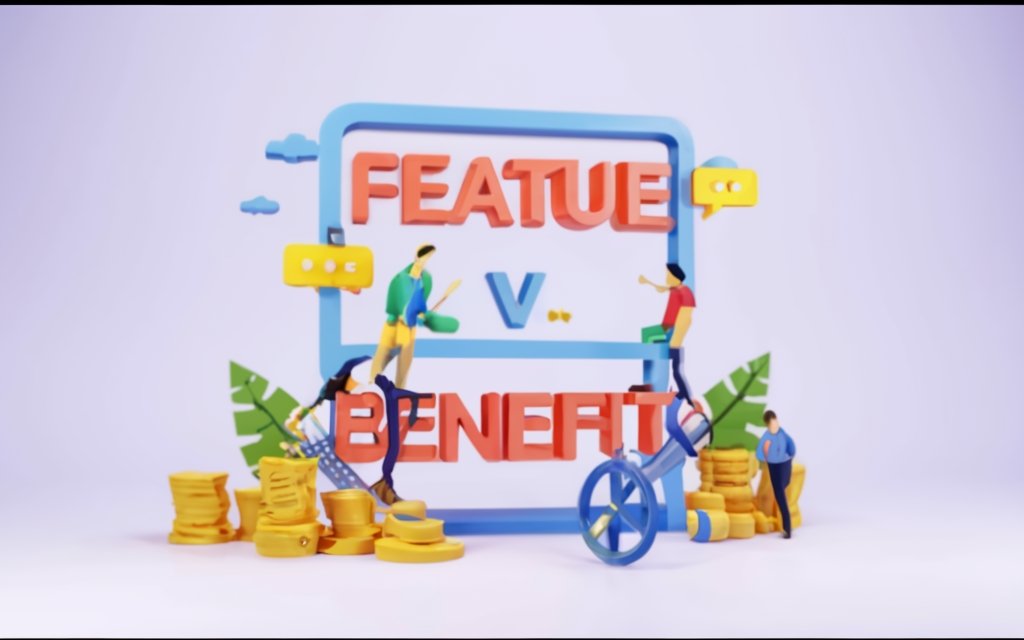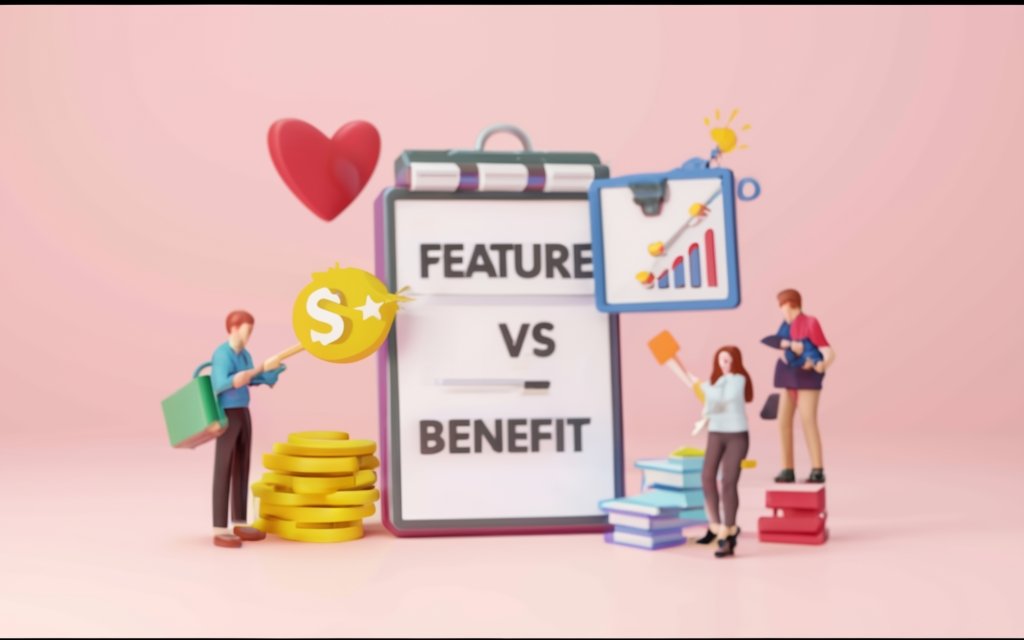Hook readers in by highlighting the immense power of benefit selling.
Does your marketing obsess over product features while prospects yawn? Shift gears to spotlight how you improve lives. Welcome to the essential guide to features vs benefits selling. Master this skill and watch conversions skyrocket.
Understanding the Core Difference Between Features and Benefits
For any business selling a product or service, being able to effectively communicate its value is critical. A key part of crafting compelling messaging is understanding the fundamental difference between features and benefits – and knowing when to focus on one versus the other.
Defining Product Features and Benefits
Simply put, features describe the facts and specifications of what a product or service is and does. They are the attributes that set it apart from competitors. For a SaaS company, features may include functionality like analytics, automation, or collaboration tools. For a physical product, they may include technical specs, materials used, or patented technologies integrated into the design.
Benefits, on the other hand, describe the positive outcomes and advantages that customers get from those features. How will using the product make the customer’s life easier, better, more productive, or more enjoyable? Benefits focus on the emotional value proposition and appeal to the buyer’s aspirations, pain points, and desires.
Consider a smartphone. Some key features could be:
- 6.5″ OLED display with HDR support
- Quad camera system with 50MP wide, 12MP ultrawide, 10MP 3x telephoto, and TOF 3D depth sensor
- Octa-core processor and 12GB RAM
The related benefits for a buyer might include:
- View content and play games with incredible vividness and detail
- Capture stunning photos and video in any environment
- Multitask and navigate apps smoothly without lag or wait times
For any given product, there are usually multiple features that translate into a single compelling benefit. Effective marketing involves identifying those high-level benefits and mapping the supporting features accordingly.
Why Features ≠ Benefits: Appealing to Emotions vs Specs
There’s an important psychological distinction between features and benefits that influences how consumers evaluate potential purchases. Although features are critical for allowing products to deliver benefits, the benefits themselves pack more emotional punch.
People don’t buy products simply for the sake of buying – they buy to fulfill wants and needs. Shoppers don’t think “I’d like to acquire a 5G-enabled handheld computer with a high resolution display.” Rather, they imagine how much more enjoyable video calls with family will be on a crystal clear screen, or how seamless it will be to stream movies on the go.
Features are weighed analytically – does this have what I want? Benefits, however, are felt intuitively – will I enjoy this? Effective marketing connects with customers’ emotions and paints a compelling vision of life with your product.
Of course, certain products like enterprise software have buyers who do care deeply about technical capabilities and specs. Even then, though, experienced salespeople know they must still translate features into business outcomes like increased efficiency, cost savings, and competitive advantage. They focus on the meaning behind the specs – the benefits.
When to Focus on Features vs Benefits in Messaging
Given the different impact of features vs benefits, when should marketers emphasize one vs the other? There are a few key principles to keep in mind:
- Attracting attention: Benefits in headlines and intro copy. Open with the value.
- Educating buyers: Features when explaining product details. Back up benefits with facts.
- Comparing options: Features to differentiate vs competitors on technical specs.
- Closing sales: Benefits to drive urgency and emotion. Remind buyers of the “after”.
Certain products and services also lend themselves more to either features or benefits:
- Features for: Technical/complex products, niche/B2B markets where specs matter, products with unique capabilities
- Benefits for: Consumer products, common/mature products where benefits are assumed, intangible services or experiences
The buyer’s journey stage is also key – benefits hook interest, while buyers look more for features during evaluation. Ultimately, leading with emotional benefits and backing up with factual features is an effective combination.
In today’s buyer-centric landscape, while features are still essential, marketers must connect products to human needs and aspirations. Combine features and benefits, but focus on showing how you’ll improve customers’ lives.

Leveraging Features and Benefits Throughout the Buyer’s Journey
The buyer’s journey is the process buyers go through when researching, evaluating, and deciding on a purchase. Smart marketers don’t just blanket target an audience – they map messaging and content to where prospects are in their journey. When it comes to features and benefits, the emphasis should shift across the different stages.
Attracting Attention with Benefits-Focused Messaging
The first goal is grabbing interest in the early awareness and consideration phases. Prospects are asking “What’s out there?” and “Does this relate to me?” This is where emotional benefits shine.
For example, email marketing platform provider Moosend promises “Email Marketing Evolved” in its slogan. This immediately catches attention by positioning the product as a superior solution. The headline on its homepage reads “Say Hello to Marketing Automation Made Easy,” emphasizing the simplicity benefit. A consumer sees how the product makes their life less stressful.
Other ways to lead with benefits include:
- Social media posts highlighting how a product could improve daily experiences
- Blog posts and videos that tap into common frustrations and demonstrate how your product alleviates them
- Paid ads focused on desirable outcomes like growth, savings, or peace of mind
This initial hook captures interest and primes prospects on why they should care about your features.
Qualifying Leads by Aligning Features and Needs
Once a prospect expresses interest and you have their contact info, the focus shifts to lead qualification and vetting. This stage is all about aligning product capabilities to the buyer’s situation through two-way discovery.
Sales teams will demo key features and have prospects explain their specific wants, needs, and pain points. These discovery conversations reveal where product attributes and customer needs intersect. For example, highlighting an analytics feature to a prospect frustrated by guessing games with ad spend.
Ways to explore feature-need fit include:
- Product demos to detail capabilities most relevant to this buyer
- Adding context to feature lists like “This helps you…”
- Competitive comparisons to showcase “only we have…” benefits
- Questionnaires on usage needs and scenarios
This exchange maps product features to real-life benefits for that particular buyer. The more relevance conveyed, the warmer the lead.
Convincing Buyers With Benefit-Driven Content
As leads become hotter marketing prospects engaging further, the focus expands beyond the product alone to more educational, vertical-specific content. Buyer concerns shift from “Does this work for me?” to “Should I proceed with this company?”
Benefit-centric thought leadership builds confidence in the value you provide and why customers consistently choose you over alternatives. For example, content like:
- Articles on best practices for extracting more value from your product
- Case studies profiling customers and the transformations/results achieved
- Industry trend reports that position your product as aligning to where things are heading
- Guides on avoiding common pain points or achieving goals
This content indirectly features your product by spotlighting the positive end-state it enables. It convinces buyers you grasp their deeper needs and priorities.
Of course, leads will still have technical product questions. Support that with helpful explainers, pricing/trial offers, and customer testimonials. Blend both types of content to nurture prospects effectively.
In summary, know when benefits grab attention, features qualify leads, and benefits again provide conviction. Adjust content accordingly throughout the journey.

Creating a Winning Feature-Benefit Strategy
Crafting compelling messaging is both an art and a science. While the difference between features and benefits is clear conceptually, strategically leveraging them takes work. Here are proven tips for building an effective feature-benefit strategy that will boost conversions.
Steps for Identifying Powerful Benefits for Any Product
The first step is getting crystal clear on the actual benefits derived from your product features. Follow these steps:
Make a comprehensive feature list. Detail every capability, technology, and attribute that makes your product unique. Get exhaustive – you want to capture everything.
Map benefits to features. Next to each feature, answer the question – how does this help the customer? What outcome or advantage does it enable them to achieve? List all possible benefits, from basic to transformational.
Group and prioritize benefits. Look for common themes across the benefits and consolidate them. Identify the 3-5 most compelling high-level benefits. Those become your platform.
Clarify with customer data. Talk to past customers, run surveys, check reviews. What benefits are real users highlighting the most? Let that guide you.
Test different benefit messaging. Run A/B tests or surveys on value propositions like “saves you time” vs “easy to use” vs “increases sales. The resonance will show you what hits home.
This process ensures you derive benefits directly from real product attributes versus making vague claims. The data validates what matters most to customers. With core benefits identified, you have a framework for messaging.
Tips for Crafting Compelling Feature vs Benefit Messaging
Your messaging itself must make the benefits clear and relatable while supporting with specific features. Tactics include:
Lead with the benefit. Open with a compelling high-level benefit statement or question – e.g “Want more time to focus on growth?”
Transition to features. Describe how one or more product features enables that benefit – e.g. “Our AI-powered automation does the repetitive work for you.”
Use visuals. Show rather than just tell. Illustrate someone leveraging a feature to enjoy the benefit – relaxing while tech does admin tasks.
Quantify benefits. Attach measurable results to benefits – “Clients save 15+ hours a week with our automation features.” Solid proof points.
Align benefits to buyer needs. Craft messages for key roles – how execs will cut costs, how marketers will boost conversions.
Avoid generic claims. Stray from vague benefits like “easy-to-use”, “better”, “empowering”. Back up claims with specific advantage examples.
Use emotive language. Don’t just describe the benefit factually, use words that pack a punch: “revolutionize”, “turbocharge”, “unleash”.
With practice, you’ll get comfortable translating technical capabilities into meaningful customer advantages. Soon it will become second nature.
Optimizing Ad Copy and Landing Pages for Conversions
Ads and landing pages are often the first touchpoints for customers, so making a strong first impression is critical. Some tips for showcasing features and benefits in those assets:
Ad headlines: Lead with the most compelling benefit – e.g. “Unlimited Cloud Storage”
Ad copy: Follow up with 1-2 key features that enable that benefit – e.g. “1TB capacity per user”, “File versioning”
Hero sections: Emphasize the high-level emotional benefit upfront through a tagline, value proposition etc.
Above the fold copy: Expand on features that deliver that benefit. Stack 3-4 together to build urgency.
Product descriptions: Use bullet points to break down features & matching benefits for easy scanning.
Visuals and graphics: Depict personas leveraging features and clearly enjoying the benefit – e.g. storing all their files without worry.
Testimonials: Select ones that rave specifically about an outcome enabled by your product’s capabilities.
When visitors first encounter your product, you want crystal clarity on its value. A compelling benefit teaser followed by supporting features is the perfect combo.
With a refined features and benefits framework, impactful messaging comes much easier. Now you’re ready to connect with customers in a way that truly resonates.
Real-World Examples of Effective Feature-Benefit Marketing
The best way to understand effective feature-benefit selling is to look at real-world examples. The following case studies demonstrate smart ways to combine product features and customer benefits across several industries.
Software Industry (HubSpot, Slack)
The software industry relies heavily on feature-benefit messaging to convey value. Take HubSpot, a popular marketing, sales, and CRM platform. Its homepage tagline reads:
Get more leads and close more deals with the first CRM you’ll actually want to use.
This leads with two clear benefits – more leads and deals. It then supports those benefits by positioning HubSpot as easy-to-use compared to typical CRM software.
HubSpot also publishes an ebook titled “Do More with Email Deliverability”. The title sums up the benefit, while the cover image depicts a frustrated person with a full email inbox. This brilliantly visualizes the pain point relieved.
Meanwhile, Slack takes a very benefit-driven approach in its messaging. One homepage section simply states:
“Make working life simpler, more pleasant, and more productive.”
The adjacent graphic of a smiling woman starting her workday hammers the benefits home. Slack wants you to feel how it improves life before diving into features.
Consumer Tech (iPhone, Dyson Humidifier)
For consumer products, Apple is the master of conveying technical features as lifestyle enhancement benefits. Its iPhone page sells the flagship smartphone with copy including:
“A magical new way to interact with iOS. The A14 Bionic chip takes machine learning to a whole new level.”
This leads by framing the touchscreen interface and processing power as magic, an emotional benefit. But it still grounds it in the features.
Meanwhile, Dyson positions its smart humidifier by saying:
“Automatically senses and reacts to changes in room conditions to maintain your chosen humidity level and temperature.”
The benefit of health and comfort is implicit. And it’s made possible by the integrated sensors and algorithms – technical features that provide value in the background.
Financial Services (Square, American Express)
Financial brands also blend features and benefits in their positioning. Payments provider Square directly says:
“Get paid fast with Square and sign up in minutes.”
The first part is an obvious cashflow benefit. And the “minutes” claim highlights the speed and simplicity features.
American Express targets affluent customers with marketing for its premium cards stating:
“Pay Over Time with Plan It®. Split eligible purchases into monthly payments with a fixed fee.”
The “Pay Over Time” benefit conveys spending flexibility and floating expenses. While Plan It® and fixed fee speak to product capabilities that enable this.
These examples demonstrate that regardless of industry, there are always strategic ways to connect what your offering does to what it means for customers. Test different angles to find what resonates best with your market.

Common Pitfalls to Avoid with Feature vs Benefit Selling
Mastering feature-benefit selling takes work. There are several common mistakes companies make that undermine results. Being aware of these pitfalls can help avoid falling into them.
Focusing Too Much on Product Specs, Not Enough on Value
One of the biggest errors is putting too much emphasis on features versus benefits. Considering the customer’s perspective is essential.
For example, cloud storage providers highlight capacities like 1TB. But users don’t care about terabytes – they care about easily accessing family photos or not running out of space for important documents. Don’t assume prospects understand the value of a feature – spell it out.
This applies to technical B2B products too. For example, stating your solution uses “an innovative distributed NoSQL database” doesn’t mean much to non-technical buyers. Explaining it enables unlimited scalability as they grow is more compelling.
Each feature should tie clearly to an end-user advantage. Don’t make customers connect the dots themselves. Prioritize benefits over specs.
Forgetting to Highlight Differentiators
Another misstep is failing to call attention to your product’s unique differentiators. This is critical for positioning against alternatives.
Don’t assume prospects appreciate differentiating capabilities. For example, if you offer the only solution in your market that can automate Z and deliver X benefit, call that out explicitly. Explain what sets you apart.
This is especially important for startups competing against established players. Touting your advanced AI algorithm means little if incumbent systems seem capable too. Articulate precisely how you surpass them.
Use benefits-driven messaging to boldly showcase your edge. For example:
“Our conversational bots enhance customer satisfaction by 74% compared to rules-based chatbots limited to simple FAQs.”
Misalignment Between Marketing and Sales Messaging
Inability to translate marketing language into resonance sales conversations also hinders success. There must be internal cohesion.
For instance, marketing may push a “360-degree customer view” as a benefit. But sales finds customers just want data consolidation to simplify workflows. They haven’t linked the two.
Joint account planning can expose these gaps. Review where marketing benefits actually manifest for customers daily. Then realign messaging and positioning across the funnel.
Additionally, sales should funnel field insights back to marketing. If they’re having to re-explain or reframe certain features and benefits regularly, content needs updating to convey clearer value.
Marketing and Sales must collaborate closely, continually optimizing how product attributes address customer priorities. Avoid devoid product gushing.
Make sure messaging evolves alongside market changes too. Yesterday’s differentiating benefit may be today’s basic expectation. Stay on top of shifting buyer needs.
In summary, there are several ways companies underoptimize their feature vs benefit selling. But being cognizant of these hazards makes it easier to avoid them. Keep the customer front and center, not the product specs.
Key Takeaways and Strategic Insights on Feature vs Benefit Selling
Effective feature-benefit selling is a crucial skill for marketers and sales professionals to master. Here are some final tips and conclusions to help refine your approach.
Recap of Best Practices
Features ≠ Benefits – Features describe product attributes, benefits describe the positive outcomes for customers. Don’t confuse the two.
Lead with benefits – Hook interest by showcasing value first. Follow up with supporting features.
Align to buyer journey – Shift focus between benefits and features based on attracting, qualifying, or convincing prospects.
Target messaging – Tailor benefits to each audience segment. What matters to executives? Frontline teams?
Back claims with proof – Quantify benefits when possible. Credible evidence drives urgency and trust.
Leverage differentiators – Spotlight your unique capabilities that competitors can’t match.
Collaborate across teams – Ensure marketing and sales benefit messaging aligns with real-world customer experiences.
Test and refine – Experiment with messaging variations to find what resonates best. Adapt to learnings.
How Feature-Benefit Selling Drives Sales in 2023 and Beyond
The bar for winning over buyers gets higher each year. Commoditization and competition erode product differentiation. Buyers face overload evaluating options. This makes feature-benefit selling more critical than ever.
Businesses must deeply understand customer aspirations and fears. Buyers want guidance solving real problems versus being sold technology. Successful brands will empathize with audiences and position offerings around desired outcomes.
For example, productivity could be framed as increased leisure time, operational efficiency as profit growth, and software accessibility as empowering non-technical users. The benefits sell the dream.
But vision must also meet execution. Features legitimize benefits. The most credible messaging clearly maps capabilities to outcomes while quantifying results. Don’t overhype.
Finally, take an outside-in perspective. Don’t obsess over minutiae only your team notices. Step into your customer’s shoes. Let their priorities shape content and campaigns. benefits that resonate externally drive growth.
The future of marketing and sales is benefits-first. Lead with transforming lives for the better. Back it up with substance. Do this exceptionally and your product sells itself.

Summary – Feature vs Benefit Selling
- Features describe product attributes while benefits describe the positive outcomes and advantages for customers. Effective messaging should focus more heavily on benefits.
- Lead with compelling high-level benefits in headlines and intros to grab attention. Follow up with supporting features and proofs.
- Adjust focus between benefits vs features based on the buyer journey stage. Benefits attract and convince, features qualify and educate.
- Truly resonate by tailoring benefits to each customer segment’s unique wants and pains. One size does not fit all.
- Quantifying benefits with data and testimony builds urgency and trust. Back claims with credible evidence.
- Explicitly call out differentiators that competitors can’t match. Position your unique value.
- Marketing and Sales must align on messaging. Continuously optimize based on real customer experiences in the field.
- Adopt an outside-in perspective. Let customer priorities and perspectives shape content and campaigns vs internal biases.
- In today’s commoditized markets, leading with benefits that tap into emotions and demonstrate meaningful outcomes is key. Back up value with substantive features.
- Mastering feature-benefit selling leads to content and messaging that sells itself. Prospects will intuitively recognize how you can improve their lives.
Frequently Asked Questions
Q: What is the difference between features and benefits in marketing?
A: Features describe objective product attributes and specifications. Benefits describe the positive outcomes and advantages customers receive from those features.
Q: Should I focus more on features or benefits in my messaging?
A: Generally, you should lead with the key benefits consumers care about most. Support those with features that enable the benefits.
Q: How do I identify the true benefits my product offers?
A: Talk to customers, analyze reviews, run surveys to understand what outcomes they value most. Their own words often convey benefits clearly.
Q: How do I highlight benefits if my product is technical?
A: Avoid getting bogged down in technical jargon. Explain how a technical feature translates into real-world value for the user. Speak to their priorities.
Q: How much detail should I provide on features?
A: Enough to substantiate your benefit claims, but don’t overcomplicate. Keep features simple, accessible and relevant to the benefits highlighted.
Q: Should ads and landing pages focus on features or benefits?
A: Lead with the most compelling benefits, then list key features that enable that benefit. Images also help convey benefits visually.
Q: How can I ensure my team aligns on features and benefits?
A: Create a feature-benefit matrix collaboratively. Review customer data together. Continuously optimize based on sales insights.
Q: What if my product lacks obvious benefits?
A: Every product solves a problem. Highlight outcomes like saving time, reduced costs, or improved experiences. Get creative on selling the dream.

